
UseAndCare
Cdl our Conoumr &oiManco Contu
with quadon 01 eommonb.
DISHWASHER MODEL SERIES 400,800,810,830,840
PART NO. 3373757 Rev. A
3194

UseAndCare
Cdl our Conoumr &oiManco Contu
with quadon 01 eommonb.
DISHWASHER MODEL SERIES 400,800,810,830,840
PART NO. 3373757 Rev. A
3194

A Note to You
Thank you for buying a Whirlpool0 appliance.
Because your life is getting busier and more complicated, Whirlpool dishwashers are easy to use, save time, and help you manage your home better. To ensure you enjoy years of trotifree operation, we developed this Use and Care Guide. It contains valuable information about how to operate and maintain your appliance properly and safely. Please read it carefully.
Also, please complete and mail the Ownership Registration Card provided with your appliance. Thii card helps us notify you about any new information on your appliance.
Please record your model???s information.
Whenever you call to request service for your appliance, you need to know your complete model number and serial number. You can find this information on the model and serial number label (see diagram on page 4 for bcation a4 label).
Please atso record the purchase date of your appliance and your fiealefs name, addrws, and telephone number.
Model Number
Serial Number
Purchaee Date
Dealer Name
DealerAddrew
Dealer Phone
Keep this book and the sales slip together in a safe place for future reference.
l Have your dishwasher installed by a qualifii installer.
l Install where dishwasher is protected from the elements.
l Install and level dishwasher on a floor that will hokf the weight, and in an area suitable for its size and use.
l Properly connect dishwasher to electrioii, water, and drain.???
l See Installation Instructions for complete Information.
l
l
l
l
Remove all shipping plugs from hoses and connectors (such as the cap on the drain outlet) before installing.*
Remove all hang tags and temporary labels. Make sure dishwasher is not used by anyone unable to operate it properly.
Properly maintain dishwasher. See page 18.
2
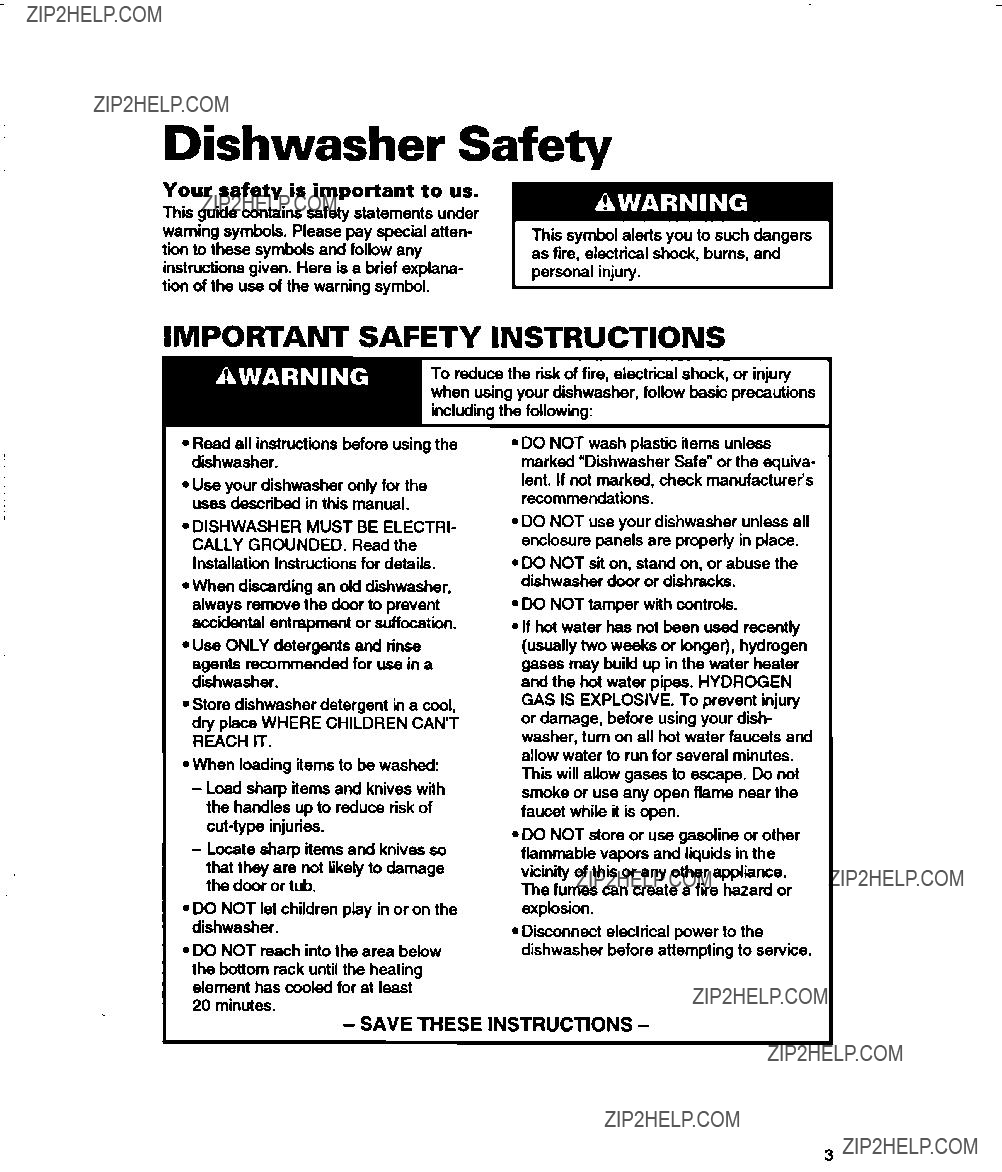
Dishwasher Safety
Your safety is important to us.
This guide contains safety statements under warning symbols. Please pay special atten- tion to these symbols and follow any instructions given. Here is a brief explana- tion of the us8 of the warning symbol.
This symbol alerts you to such dangers as fire, electrical shock, burns, and personal injury.
IMPORTANT SAFETY INSTRUCTIONS
l Read all instructions before using the dishwasher.
l Use your dishwasher only for the uses described in this manual.
.DISHWASHER MUST BE ELECTRI- CALLY GROUNDED. Read the Installation Instructions for details.
l When discarding an old dishwasher, always remove the door to prevent accidental entrapment or suffo&ion.
@Use ONLY detergents and rinse agents recommended for use in a dishwasher.
l Store dishwasher detergent in a cool, dry place WHERE CHILDREN CAN???T
REACH IT.
*When loading items to be washed:
-Load sharp items and knives with the handles up to reduce risk of
-Locate sharp items and knives so that they are not likely to damage the door or tub.
l DO NOT let children play in or on the dishwasher.
.DO NOT reach into the area below the bottom rack until the heating element has cooled for at least
20 minutes.
l DO NOT wash plastic items unless marked ???Dishwasher Safe??? or the equiva- lent. If not marked, check manufacturer???s recommendations.
l DO NOT use your dishwasher unless ail enclosure panels are properly in place.
l DO NOT sit on, stand on, or abuse the dishwasher door or dishracks.
@DO NOT tamper with controls.
l If hot water has not been used recently (usually two weeks or longer), hydrogen gases may build up in the water heater and the hot water pipes. HYDROGEN GAS IS EXPLOSIVE. To prevent injury or damage, before using your dish- washer, turn on ail hot water faucets and allow water to run for several minutes. This will allow gases to escape. Do not smoke or use any open flame near the faucet while it is open.
@DO NOT store or use gasoline or other flammable vapors and liquids in the vicinity of this or any other appliance. The fumes can create a fire hazard or explosion.
l Disconnect electrical power to the dishwasher before attempting to service.
- SAVE THESE INSTRUCTIONS -
3

Parts and Features
Your dishwasher is illustrated below with the parts and features information on specific parts or features quickly, page references
Third level wash
Water inlet opening
(P- 9)
W
;;;+I$
>
Heating element
called out. To help you find are included.
Silverware
Overfill protector
(P. 19)
Detergent dispensers
(P. 10)
4

Series 400 models
Series 800 models
Series 8 10 models
Series 830 models
V
Selector button8
Series 840 models
v v
Cycle 8elector Optlon 8dector button8 button8
Option selector Cycle control knob switch
I I
Option selector Cycle control knob switch
I I
Option relector Cycle control knob rwitch
I
Cycle control knob
I
Cycle control knob
5
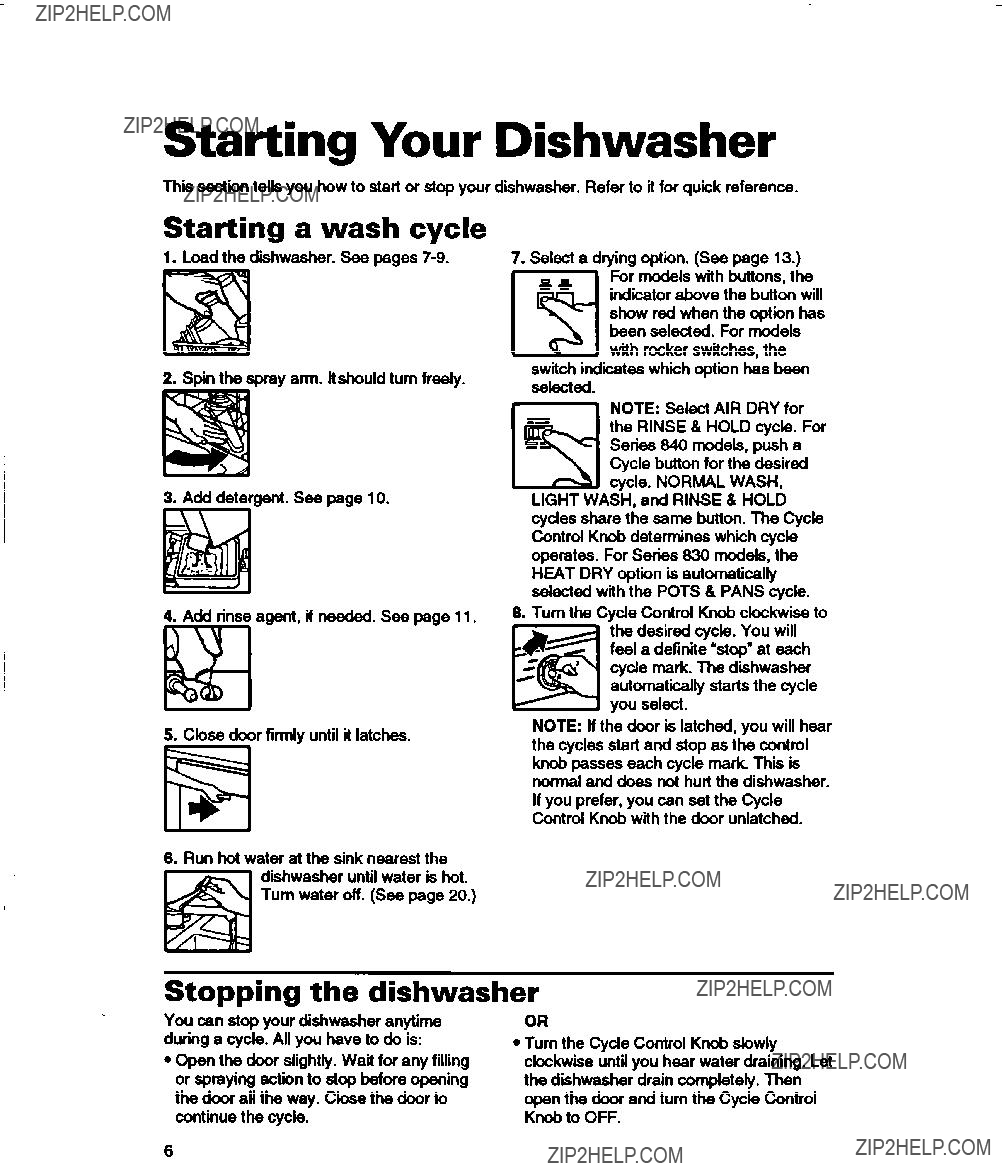
Starting Your Dishwasher
This section tells you how to start or stop your dishwasher. Refer to it for quick reference.
Starting a wash cycle
1. Load the dishwasher. See pages
. -
y amt. ftshould turn freely.
gent. See page 10.
agent, if needed. See page 11.
5.Close door firmly until il latches.
6.Run hot water at the sink nearest the
dishwasher until water is hot. Turn water off. (See page 20.)
7. Select a drying option. (See page 13.)
LIGHT WASH, and RINSE 8 HOLD cychs share the same button. The Cycle Control Knob determines which cycle operates. For Serifs 630 models, the HEAT DRY option is automatically
s&dad with the POTS & PANS cycle.
6. Turn the Cycle Control Knob clockwise to the desired cycle. You will
feel a definite ???stop??? at each cycle mark. The dishwasher automatically starts the cycle you select.
NOTE: lf the door is latched, you will hear the cycles start and stop as the control knob passes each cycle mark. Thii is normal and does not hurl the dishwasher. If you prefer, you can set the Cycle Control Knob with the door unlatched.
Stopping the dishwasher
You can stop your dishwasher anytime during a cycle. All you have to do is:
l Open the door slightfy. Wait for any filling or spraying action to stop before opening the door all the way. Close the door to continue the cycle.
OR
l Turn the Cycle Control Knob slowly cfockwiie until you hear water draining. Let the dishwasher drain completely. Then open the door and turn the Cycle Control Knob to OFF.
6

Loading Your Dishwasher
This section tells how to proper& load your dishwasher for best washing and rinsing results.
Preparing to load the
l To save water and energy, do not rinse diis before putting them into the dishwasher.
l Remove large pieces of food, bones, and other hard items.
l Foods like eggs, rice, pasta, and cooked cereals may be hard to remove if left to dry over a period of time. Run a RINSE 8 HOLD cyde to keep dishes moist if you do not plan to wash them scwx.
l Load dishes so soiled surfaces face the rotating spray arm.
l Load dishes so they are not stacked or overlapping. lt is important for the water spray to reach all soiled surfaces for best washing. For best drying, water must be able to drain from all surfaces.
dishwasher
Loading for quiet operation
l Secure lightweight load items in the racks.
l Pot lids and handles, pizza pans, cookie sheets, etc., should not touch interior walls, interfere with the spray arm???s rotation, or cover the spray tower.
l Load dishes so they do not touch one another.
NOTE: Keep sink drain plugs inserted during dishwasher operation to prevent noise transfer through drains.
Loading the silverware basket
Personal Injury Hazard
Load sharp items (knives, forks, skewers, etc.) with the point down.
Failure to do so could cause personal injury.
l Load the silverware basket while it is in the bottom rack or take the basket out for loading on a counter or table.
NOTE: The loaded basket must be placed in the center front (over the spray tower) of the bottom rack for proper washing.
l Mix items in each section of the basket with some pointing up and some down to avoid nesting. Spray cannot reach nested items. However, always load sharp items (knives, skewers, forks, etc.) pointing down.
l Put small items (baby bottle caps, jar lids, etc.) in any section.
l You can also remove the basket for easy unloading. Always unfoad or remove the basket before unloading the racks to avoid
spilling water on the silverware.
7

Loading the bottom rack
Load items with
Mixed load
l
l
l
l
l
Load plates, soup bowls, etc., between prongs and facing inward to the spray.
Utensil load
l Load cookii sheets, cake pans, and other large ilems at skies and back Loading such items in front may keep water spray from reaching detergent dispenser and silverware basket.
NOTE:
l Do not load glasses, cups, or plastic items in the bottom rack.
l Do not load items between the bottom rack
and the side of the dishwasher tub. This face bi8hwasher door Y can block the water inlet opening.
l If you have removed the bottom rack for unloading or cleaning, replace it with bumpers in front.

Loading the top rack
Load the top rack with cups, glasses, and smaller items. Do not cover the third level wash (on some models) when loading the top rack.
Cup and glass load
l Load so open ends face down for cleaning and draining.
. Load glasses in top rack onty - bottom rack is not designed for glasses. Damage can occur.
l Ptace items in the rows between prongs. Placing them over the prongs may lead to breakage.
l Secure lightweight items.
l China, crystal, and other delicate items must not touch each other during dish- washer operation. Damage may occur.
Mixed load
l Small bowls, pans, and other utensils can beplacedinthetoprack.
l Load plastic items in the top rack onty. Plastic items may melt in the bottom rack.
l Wash only plastic items marked ???dish- washer safe.???
l Load plastic items so the force of the spray does not move them during the cycle.
Cup and glass load
Do not cove;thlrd level wa8h
(on some models)
9

Using the Dispensers
For best washing results, review the information below. It is important to use detergents and rinse agents properly.
Using the detergent dispenser
l Uss automatic dishwashing detergent only. Other detergents are too mild and much too sudsy.
l Add detergent just before starting cycle.
l Store detergent tightlycbsed in a cool, dry place. Fresh automatic dishwasher detergent results in better cleaning.
Filling the detergent dispenser
The detergent dispenser has one section with a cover and one without. Push cover down fim until it latches. Detergent in the open section falls into the dishwasher when closing the door. The covered section opens automatically for the main wash.
NOTE: It is normal for the cover to open partially when dispensing detergent.
lCycb on soma models only.
How much detergent to use
l The amount of detergent to use depends on the hardness of your water and the type of detergent. If you use too little, dishes won???t be clean. If you use too much in soft water, glassware will etch.
l Different brands of dishwasher detergent have different amounts of phosphorus for softening water. lf you have hard water and use bw phosphorus content detergent (6.0% or less), you may need to use more detergent or use a detergent with a higher phosphorus content (8.7%).
l Find out your water???s hardness by asking your local water department, water soft- ener company, or county extension agent.
Fill amounts shown are for standard powdered detergent. Amounts may vary if you use liquid or concentrated powdered detergent. Follow manufacturer???s directions when using liquid dishwasher detergent or concentrated powdered detergent.
10

Using the rinse agent dispenser
Keep the rinse agent dispenser filled with a liquid rinse agent. A rinse agent greatly Improves dish drying by helping water fIow off them during the last rinse. A rinse agent also keeps water from forming
droplets and drying as spots or streaks. A small amount of rinse agent automati-
cally releases into the rinse water during the final rinse of each cycle. For best drying results, check dispenser periodically to see if It needs filling.
To check dispenser:
l Check center of Fill Indicator Cap. Clear means it needs filling.
OR
l Remove Fill Indicator Cap. An ???F is visible when dispenser is empty.
To fill dispenser:
The rinse agent dispenser holds 6 ounces (175 mL). Under normal conditions, this lasts about 3 months.
1.Open dishwasher door completely.
2.Remove Fill Indicator Cap.
3.Add rinse agent. Fill to smallest opening in lower part of dispenser only. Overfilling may cause rinse agent to leak out. This will not harm the dishwasher, but could cause oversudsing.
4.Clean up any spilled rinse agent with a damp cloth.
5.Replace Fill lndiitor Cap. Keep it closed tightly.
NOTE: You do not have to wait until the diinser is empty before refilling, but do not overfill it. Your dishwasher is designed to use a liquid rinse agent. You do not need to use a solid or
Do not fill paat l mbdleat opening
Keep dispenser filled for best drying resutts
11

Setting the Controls
Operating your dishwasher???s controls properly helps you obtain the best possible washing results. This section tells you how to select wash cycles and options.
Selecting a wash cycle
For Serbs 400,800, and 810 models: Turn Cycle Control Knob to desired cycle.
For Series 830 models: Press POTS & PANS button for that cycle. Or press either HEAT DRY or AIR DRY for NORMAL WASH and LIGHT WASH cycles. Press AIR DRY for RINSE 8 HOLD cycle. Turn Cycle Control Knob to desired cycle.
For Serfes 840 models: Press a cycle pad, then turn the Cycle Control Knob to desired cycle. NORMAL WASH, LIGHT WASH, and RINSE & HOLD all share the same cycle pad.
NOTE: Your model may have all or some of the cycles shown.
NORMAL WAS
soiled loads. (The Energy Guide label is based on this
RINSE & HOLD
oneorrnore
l
l
Do not use detergent.
Use AIR DRY option.
???C
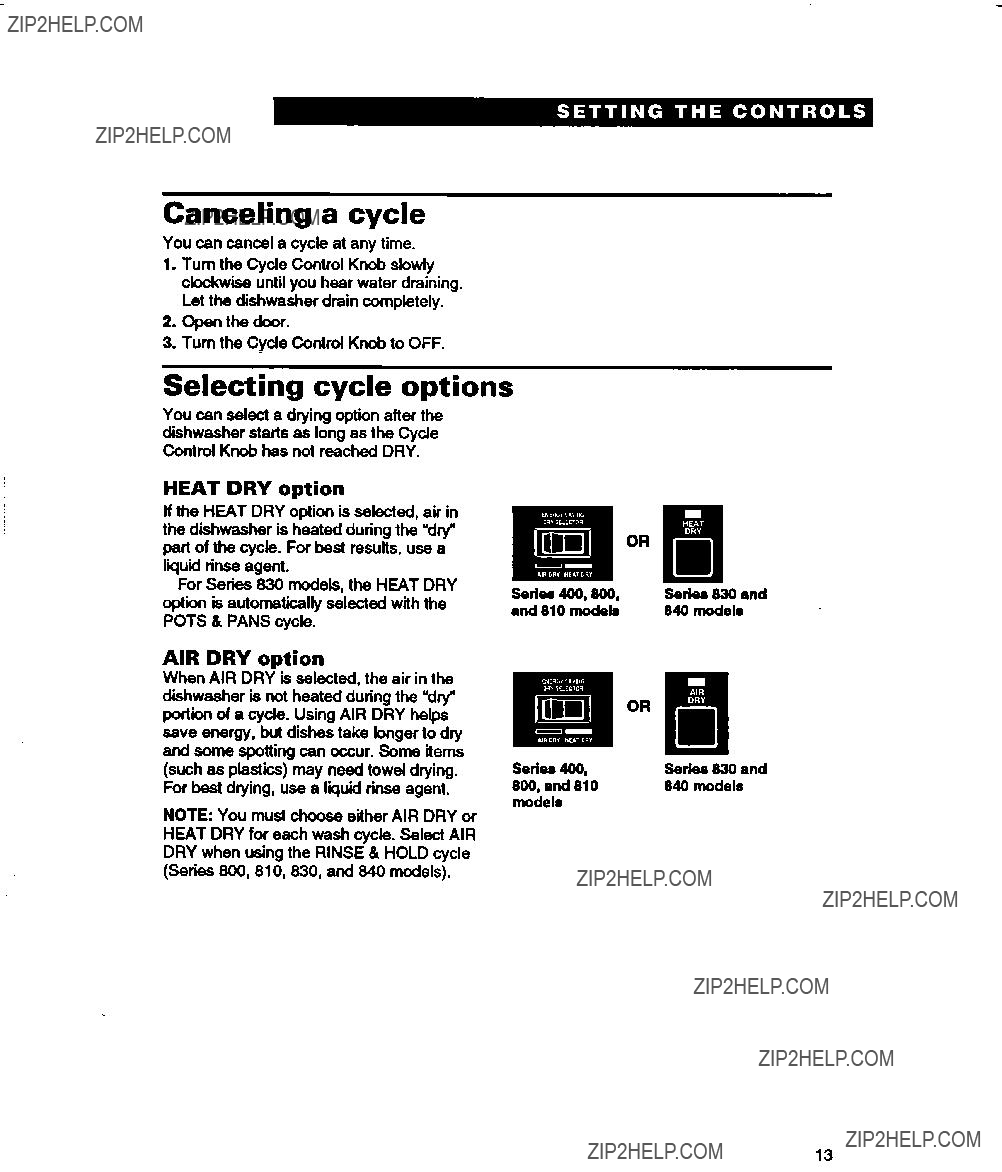
Canceling a cycle
You can cancel a cycle at any time.
1.Turn the Cycle Control Knob slowly cbckwii until you hear water draining. Let the dishwasher drain completely.
2.Open the door.
3.Turn the Cycle Control Knob to OFF.
Selecting cycle options
You can select a drying option after the dishwasher starts as long as the Cycle Control Knob has not reached DRY.
HEAT DRY option
If the HEAT DRY option is selected, air in the dishwasher is heated during the ???dry??? part of the cycle. For best results, use a liquid rinse agent.
For Serbs 830 models, the HEAT DRY option is automatically selected with the POTS 8 PANS cycle.
AIR DRY option
When AIR DRY is selected, the air in the dishwasher is not heated during the ???dry??? portion of a cycle. Using AIR DRY helps save energy, but dishes take longer to dry and some spotting can occur. Some items (such as plastics) may need towel drying. For best drying, use a liquid rinse agent.
NOTE: You must chcxxe either AIR DRY or HEAT DRY for each wash cycle. Select AIR DRY when using the RINSE & HOLD cycle (Series 800, 810, 830, and 840 models).
13
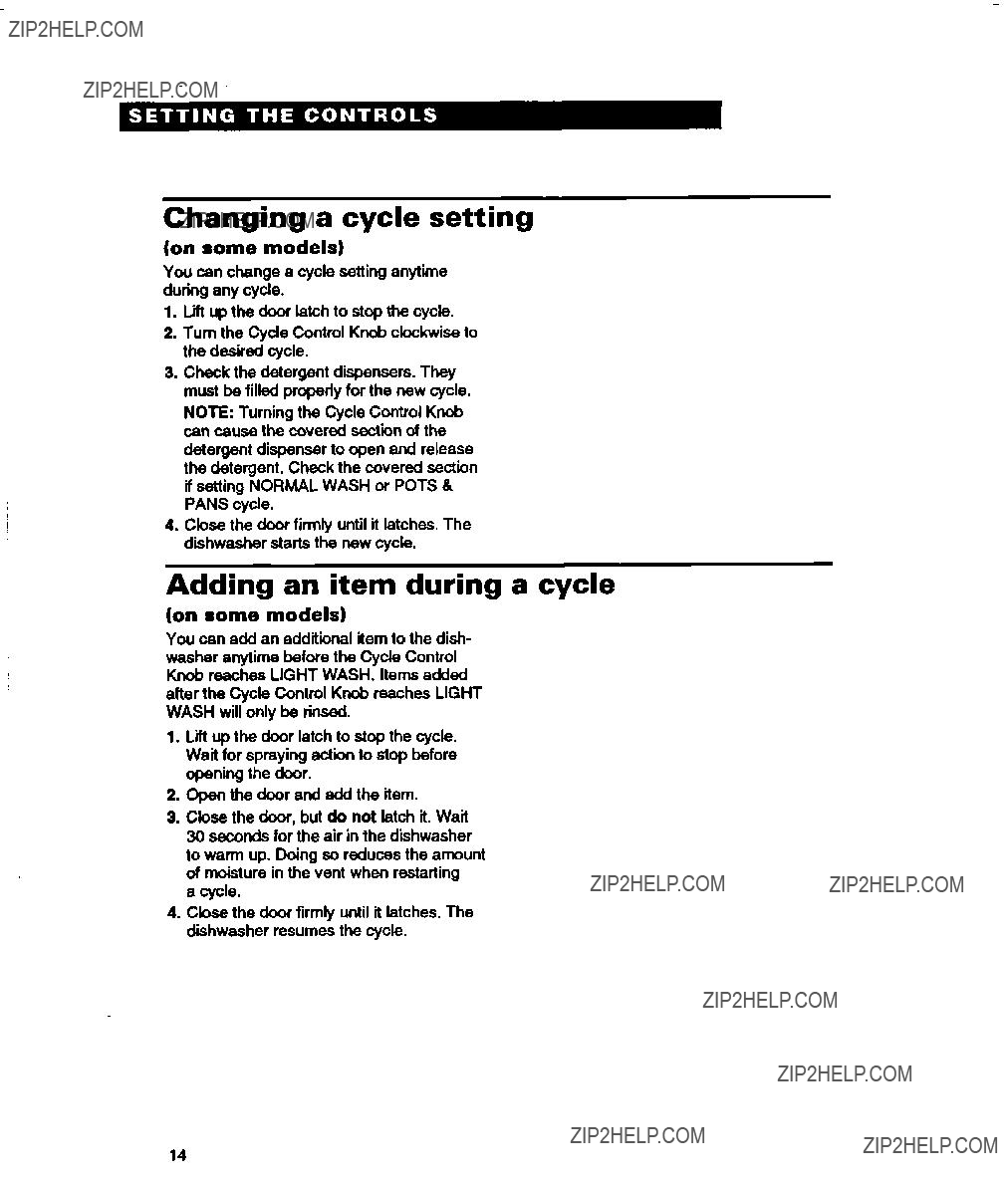
Changing a cycle setting
(on some models)
You can change a cycle setting anytime during any cycle.
1.Lii up the door latch to stop the cycle.
2.Turn the Cycle Control Knob cbckwise to the desired cycle.
3.Check the detergent dispensers. They must he filled properly for the new cycle.
NOTE: Turning the Cycle Control Knob can cause the covered section of the detergent dispenser to open and release the detergent. Check the covered section if setting NORMAL WASH or POTS 8 PANS cycle.
4.Close the door firmly until it latches. The dishwasher starts the new cycle.
Adding an item during a cycle
(on some models)
You can add an additional item to the dish- washer anytime before the Cycle Control Knob reaches LIGHT WASH. Items added after the Cycle Control Knob reaches LIGHT WASH will only he rii.
1.Lii up the door latch to stop the cycle. Wait for spraying action to stop before opening the door.
2.open the door and add the item.
3.Close the door, but do not latch it. Wait 30 seconds for the air in the dishwasher to warm up. Doing so reduces the amount of moisture in the vent when restarting
a cycle.
4.Cbse the door firmly until it latches. The dishwasher resumes the cycle.
14

Washing Special Items
L
Milk glass will yellow with repeated dishwasher washing.
Handles of some knives are attached to the bhde with adhesives which may loosen if washed in the dishwasher.
High water temperatures and detergent can discolor or pit finish.
Cannot withstand high water temperatures and detergents.
Always check manufacturer???s recommendations before washing. Plastics vary in their capacity to withstand high water temperatures and deter- gents. Load plastics in top rack only.
Run the RINSE 8 HOLD cycle if not washing immediately. Prolonged contact with food containing salt, vinegar, milk products, or fruit juice can damage finish.
Run the RINSE 8 HOLD cycle if not washing immediately. Prolonged contact with food containing salt, acid, or sulfiie (eggs, mayon- naise, and seafood) can damage finish.
Can rust.
Always check manufacturer???s recommendations before washing. Untreated wood can warp, crack, or lose its finish.
l! 5
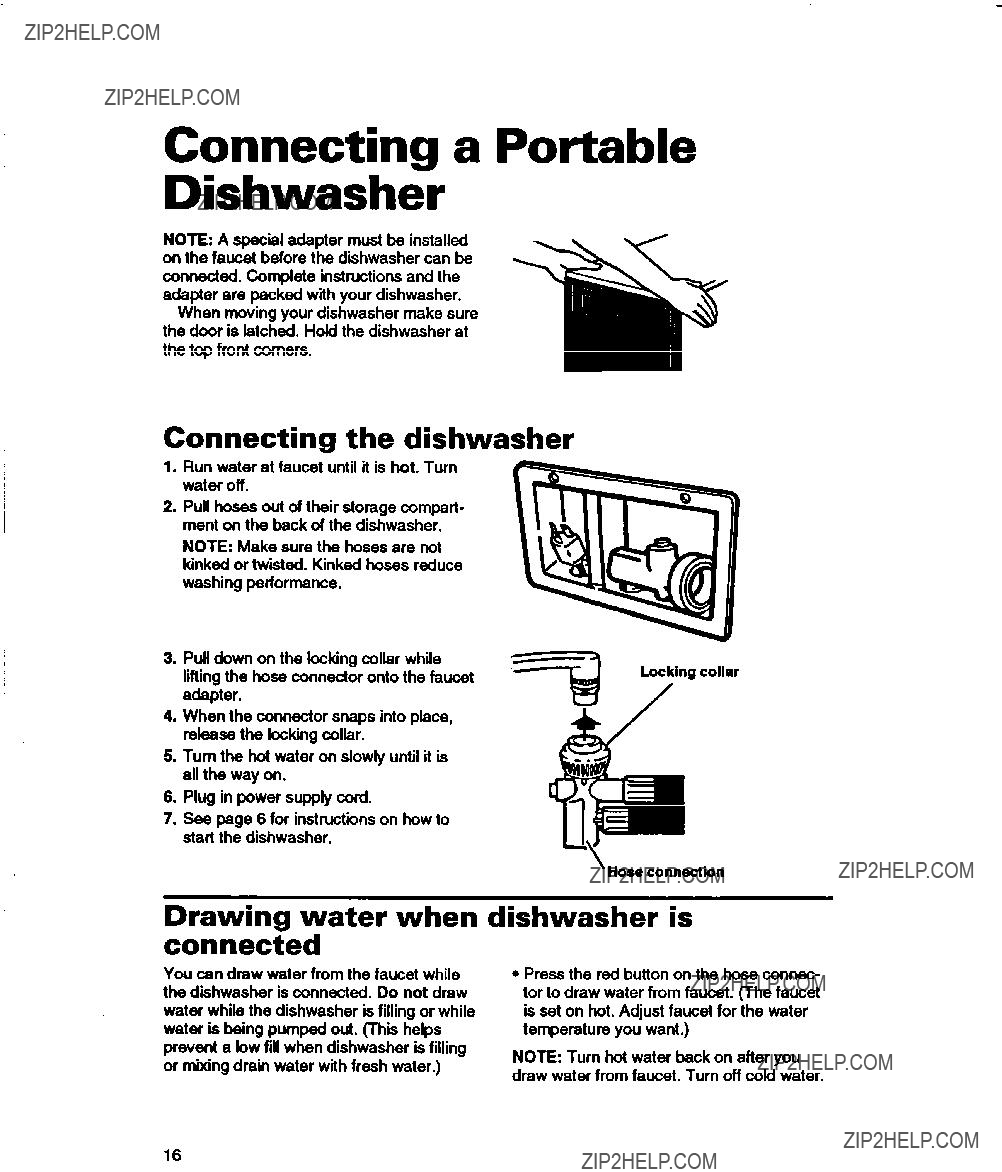
Connecting a Portable
Dishwasher
NOTE: A special adapter must be installed on the faucet before the dishwasher can be connected. Complete instructions and the adapter are packed with your dishwasher.
When moving your dishwasher make sure the door is latched. Hold the dishwasher at the top front corners.
Connecting the dishwasher
1.Run water at faucet until it is hot. Turn water off.
2.Pull hoses out of their storage compart- ment on the back of the dishwasher.
NOTE: Make sure the hoses are not kinked or twisted. Kinked hoses reduce washing performance.
3.Pull down on the locking collar while lifting the hose connector onto the faucet adapter.
4.When the connector snaps into place, release the locking collar.
5.Turn the hot water on slowfy until it is all the way on.
8.Plug in power supply cord.
7.See page 6 for instructions on how to start the dishwasher.
&/
???Hose connection
Drawing water when connected
You can draw water from the faucet while the dishwasher is connected. Do not draw water while the dishwasher is filling or while water is being pumped out. (This helps prevent a bw fill when dishwasher is filling or mixing drain water with fresh water.)
dishwasher is
l Press the red button on the hose connec- tor to draw water from faucet. (The faucet is set on hot. Adjust faucet for the water temperature you want.)
NOTE: Turn hot water back on after you draw water from faucet. Turn off cold water.
16

Disconnecting the dishwasher
1.Turn hot water off. (Thii can be done after the last rinse.)
2.Press the red button on the connector to release the water pressure.
3.Lift slightly on the hose connector while pulling down the looking collar. Pull down on the connector.
4.Empty any remaining water from the oonneotor by turning the connector upside down.
5.Unplug Power supply cord and return to
Electrical connection
Apowersup~lyof120vo#s,6OHzAC,l5or
20 amps, is required. Par your Personal safety, this appliance must be grounded. This a@ance is equipped with a power supply cord having a 3prong grounding Plug. To minimize possible shock hazard il must be plugged into a mating &Prong grounding tyfx wall receptacle, grounded in accordance with the National Electrical Code and local codes and ordinances. If a mating wall receptacle is not avaibble, it is the responsibility and obligation of the customer to have a properly grounded 3prong wall receptacle installed by a qualified electrician.
Fire Hazard
An extension cord should not be used with this appliance.
Do not, under any circumstances, remove the Power supply cord ground prow.
Such use may result in a fire, electrical shock, or other Personal injury.
Power 8upply
cord3-pro& grounding type wall receptacle
Converting a portable dishwasher to a
17
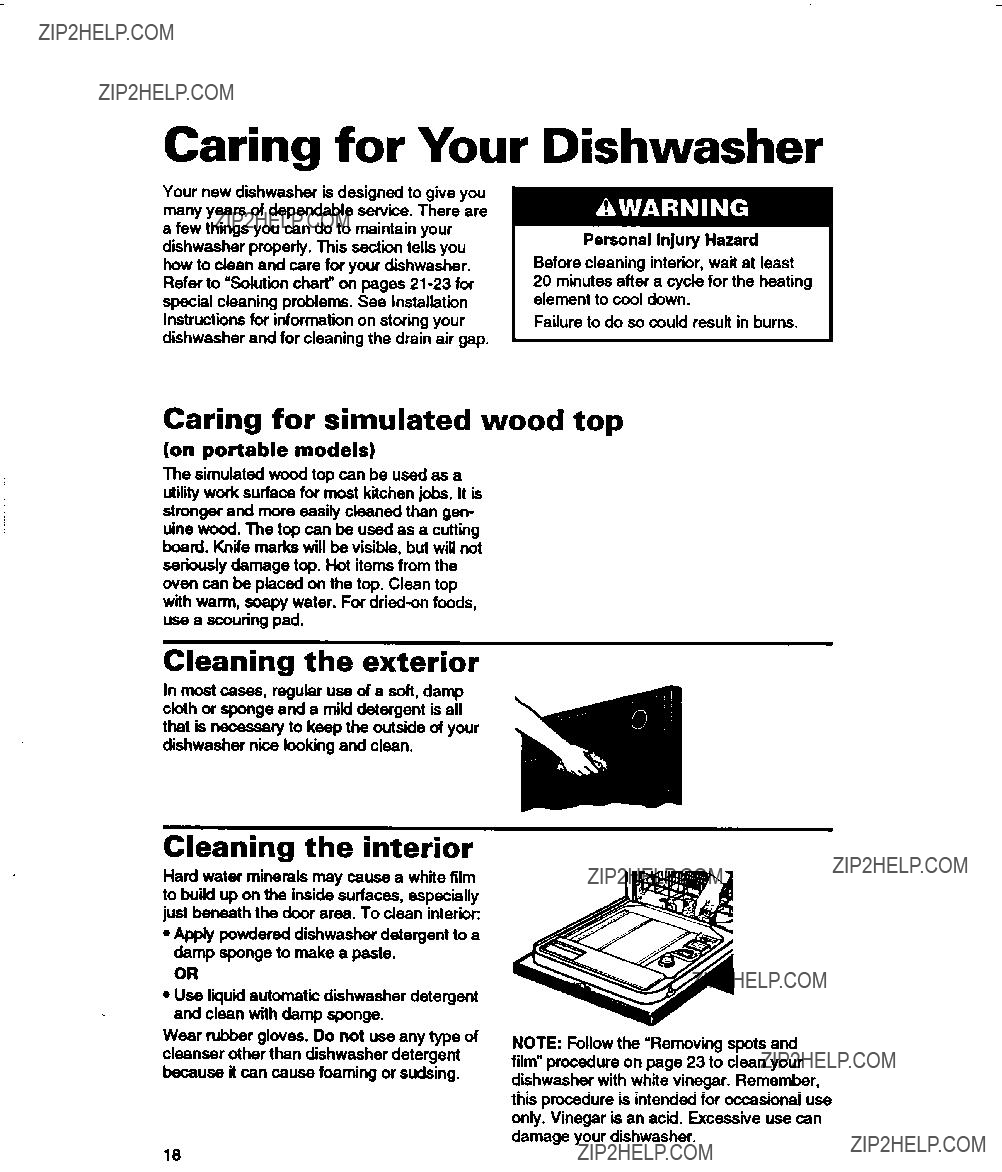
Caring for Your
Your new dishwasher is designed to give you many years of dependable service. There are a few things you can &to maintain your dishwasher properly. This section tells you how to clean and care for your dishwasher. Refer to ???Solution chart??? on pages
Dishwasher
Personal injury Hazard
Before cleaning interior, wait at least 20 minutes after a cycle for the heating element to cool down.
Failure to do so could result in burns.
Caring for simulated wood top
(on portable models)
The simulated wood top can be used as a utility work surface for most kitchen jobs. It is stronger and more easily cleaned than gen- uine wood. The top can be used as a cutting board. Knife marks will be visible, but will not seriously damage top. Rot items from the oven can be placed on the top. Clean top with warm, soapy water. For
Cleaning the exterior
In most cases, regular use of a soft, damp cloth or sponge and a miM detergent is all that is necessary to keep the outside of your dishwasher nice looking and clean.
Cleaning the interior
Hard water minerals may cause a white film to build up on the inside surfaces, especially just beneath the door area. To clean interior: l Apply powdered dishwasher detergent to a
damp sponge to make a paste.
OR
l Use liquid automatic dishwasher detergent and clean with damp sponge.
Wear rubber gloves. Do not use any type of cleanser other than dishwasher detergent because it can cause foaming or sudsing.
NOTE: Follow the ???Removing spots and film??? procedure on page 23 to clean your dishwasher with white vinegar. Remember, this procedure is intended for occasional use only. Vinegar is an acid. Excessive use can damage your dishwasher.
18
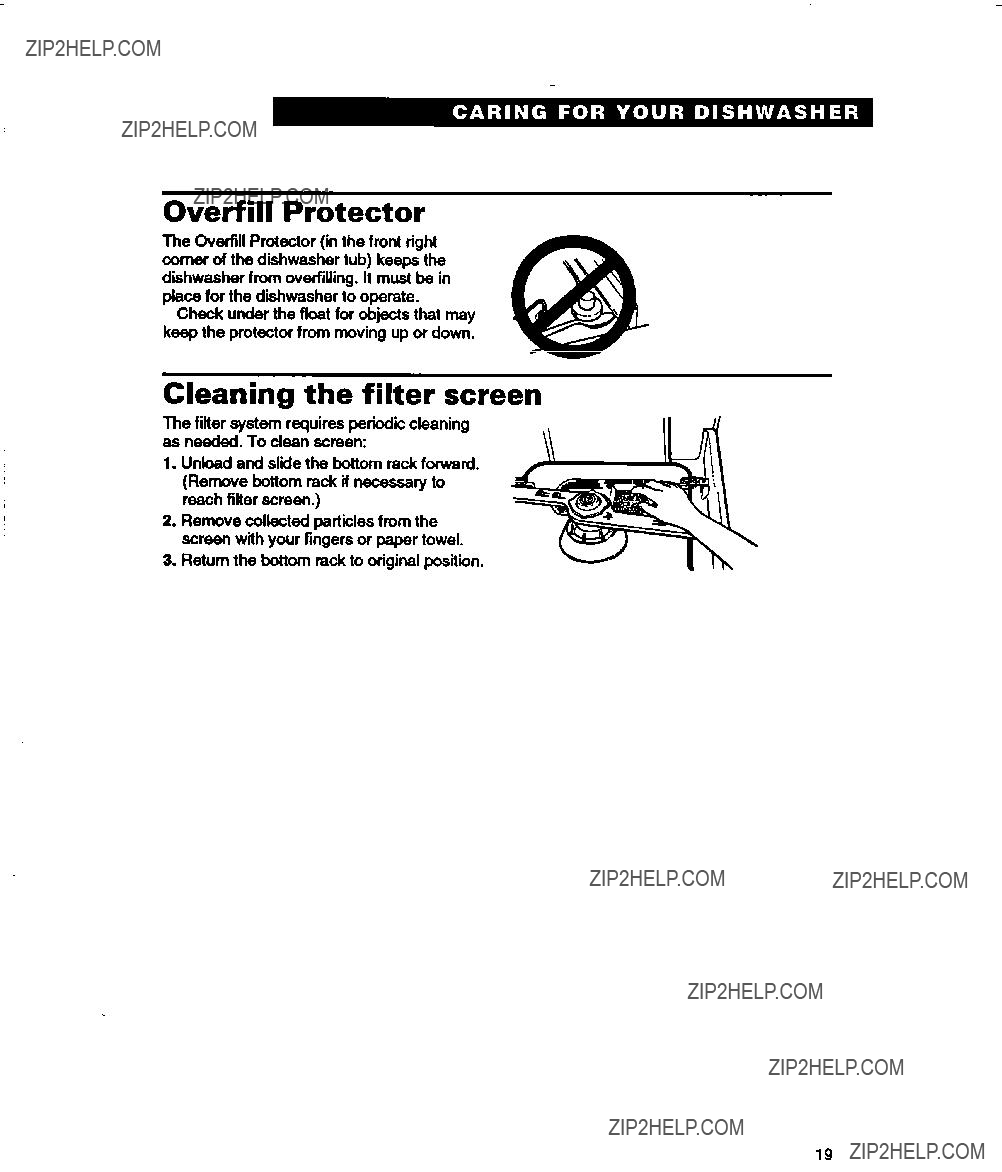
Overfill Protector
The Overfill Protector (in the front right corner of the dishwasher tub) keeps the dishwasher from overfilling. It must be in place for the dishwasher to operate.
Check under the float for objects that may keep the protector from moving up or down.
Cleaning the filter screen
The fitter system requires periodic cleaning as needd. To clean screen:
1.Unbad and slide the bottom rack forward. (Remove bottom rack if necessary to reach filter screen.)
2.Remove collected particles from the screen with your fingers or paper towel.
3.Return the bottom rack to original position.
19

Saving Energy
Saving energy is important and helps you save money. This section gives you tips on the best ways to save energy with your dishwasher.
Loading tips
l
l
l
Wash full toads. Running a
Load correctly for best washing results. Incorrect loading may cause poor washing and the need to rewash all or part of load. Do not prerinse normally soled dishes. Select the correct cycle for the bad and use the recommended amount of detergent.
Cycle and option tips
l If your model has the LIGHT WASH cycle, use it whenever possible. The cycle uses less hot water and energy than the NORMAL WASH cycle.
l Run your dishwasher during
l Use the AIR DRY option whenever pos- sible. Allow longer drying times (overnight). Use a rinse agent to improve drying.
l Loads may not wash or dry as well if the water temperature is too low. For best dishwashing resutts, water must be at least 120??F (49??C) as it enters the dishwasher.
To check water temperature:
1. Run the hot water at the faucet closest to your dishwasher. Let the water run for at least 1 minute.
ndy or meat thermometer in the running stream of water. If water temperature at the faucet is below 120??F (49??C) have a qualified person raise the water heater???s thermostat setting.
20
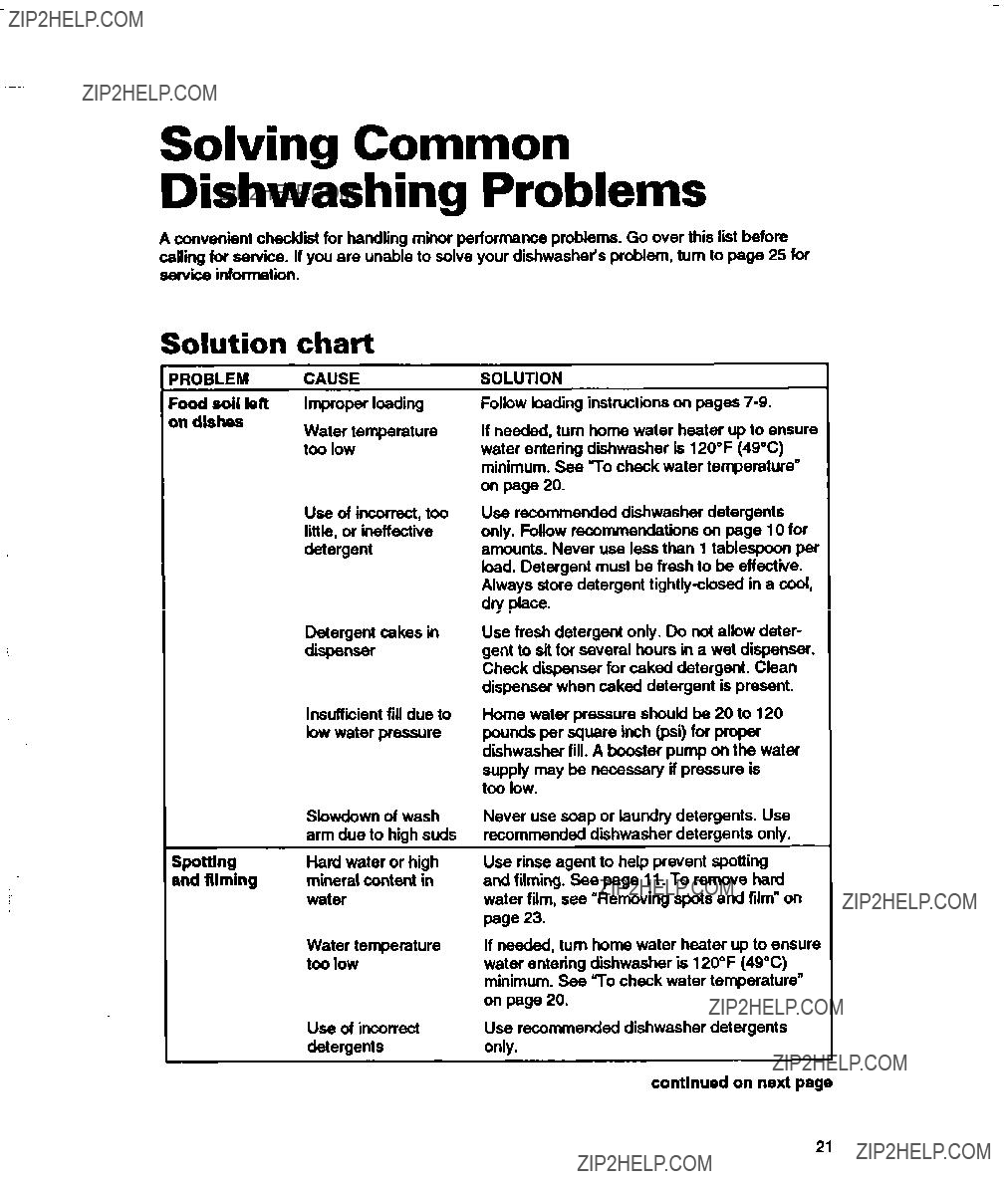
Solving Common
Dishwashing Problems
A convenient checklist for handling minor performance problems. Go over this fist before caUing for service. If you are unable to solve your dishwasher???s problem, turn to page 25 for service information.
Solution
hod soil left bndishes
Spotting md filming
chart
continued on next page
21

Plastics
SOLUTION
Follow recommendations on page 10 for amount. Heavy soil and/or hard water generally require extra detergent.
Use fresh detergent. Store detergent tightly- closed in a cool, dry place. Discard lumpy detergent.
Home water pressure should be 20 to 120 psi for proper dishwasher fill. A booster pump on the water supply may be neces- sary if pressure is too low.
Dishes must have proper water drainage. Do not overload. Follow instructions for loading dishwasher on pages
Some plastics, due to material, may need to be towel dried.
dishwasher because they may break down and cause marking. Remove aluminum markings by using a mild abrasive cleanser.
White spots on Seasoning removed by Reseason cookware after dishwasher cookware with dishwasher detergents washing.
norwtkk finish
22
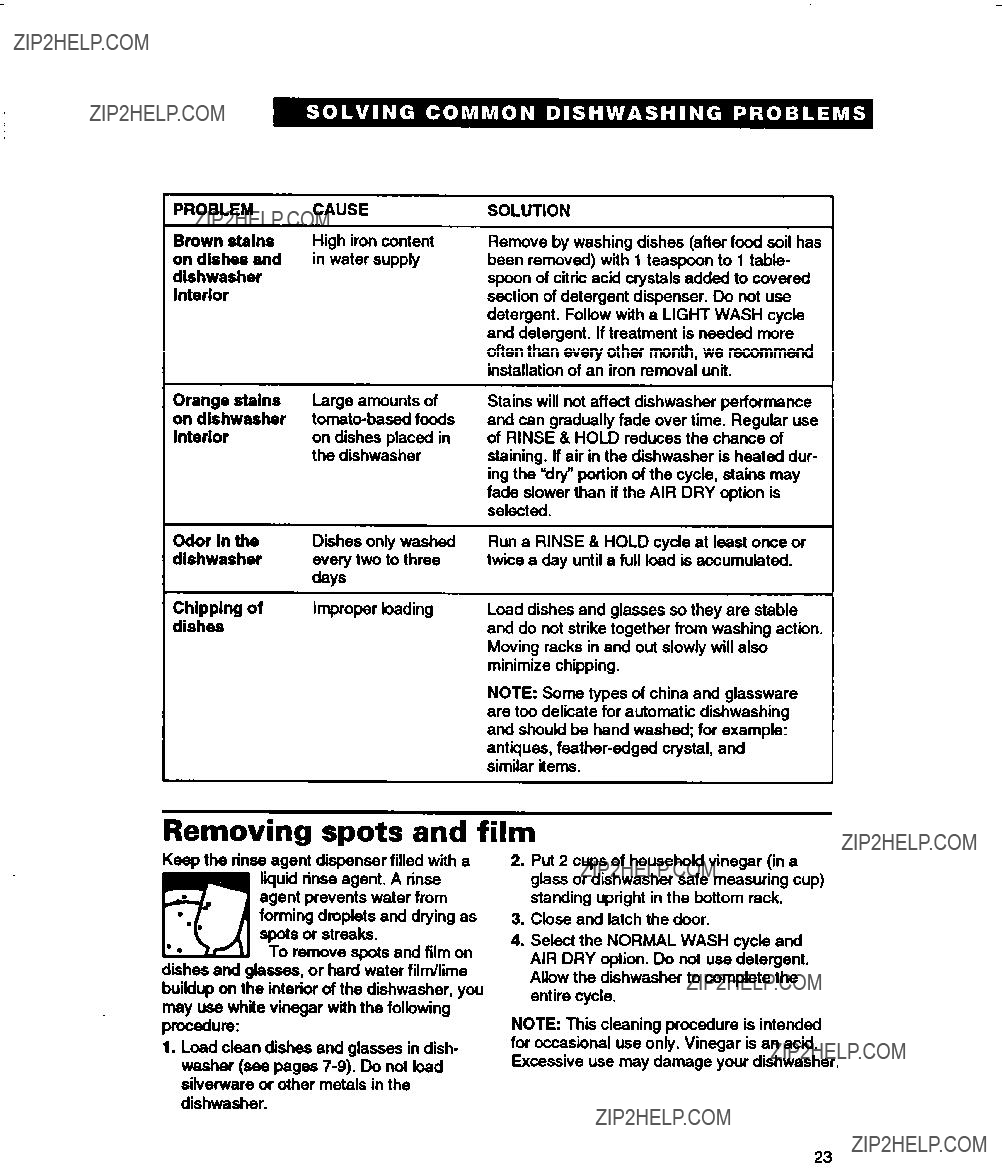
PROBLEM CAUSE
Brown stains High iron content on dishes and in water supply dishwasher
interior
SOLUTION
Remove by washing dishes (after food soil has been removed) with 1 teaspoon to 1 table- spoon of citric acid crystals added to covered section of detergent dispenser. Do not use detergent. Follow with a LIGHT WASH cycle and detergent. If treatment is needed more often than every other month, we recommend installation of an iron removal unit.
Stains will not affect dishwasher performance and can gradually fade over time. Reguhr use of RINSE 81HOLD reduces the chance of staining. lf air in the dishwasher is heated dur- ing the ???dry???portion of the cycle, stains may fade slower than if the AIR DRY option is selected.
Run a RINSE 8 HOLD cycle at least once or twice a day until a full load is accumubted.
Load dishes and glasses so they are stable and do not strike together from washing action. Moving racks in and out slowly will also minimize chipping.
NOTE: Some types of china and glassware are too delicate for automatic diihwashing and should bs hand washed; for example: antiques,
Removing spots and film
Keep the rinse agent dispenser filled with a
buikfup on the interior of the dishwasher, you may use white vinegar with the following procedure:
1.Load clean dishes and glasses in dish- washer (see pages
2.Put 2 cups of household vinegar (in a glass or dishwasher safe measuring cup) standing upright in the bottom rack.
3.Close and latch the door.
4.Select the NORMAL WASH cycle and AIR DRY option. Do not use detergent. Allow the dishwasher to complete the entire cycle.
NOTE: Thii cleaning procedure is intended for occasional use only. Vinegar is an acid. Excessive use may damage your dishwasher.
23

Troubleshooting
Before calling for assistance please check the chart below for problems you can fix. It could save you the cost of a service call.
Dishwasher
PROBLEM
Dishwasher does not run or stops during a cycle
Dishwasher will not fill
Water remains in dishwasher
Detergent remains in covered section of dispenser
Dishes not as dry as you expected
White residue appears on front of access panel
Dishwasher will not close
problems
CHECK THE FOLLOWING
Is the door tightly closed and securely latched?
Has the cycle been set correctly? See pages 5 and
Has a household fuse blown or circuit breaker tripped?
If the motor stopped because of an overload, it will automatically reset itself within a few minutes. If it does not start, call for
Is the water supply turned on?
Is the dishwasher wired into a live circuit with the proper voltage?
Is the Overfill Protector stuck in Qp??? position? Overfill Protector should move up and down freely. Press down to release. See page 19.
Allow cycle to finish. A small amount of water remaining is normal.
Check the drain air gap (if installed). If it is clogged, follow the manufacturer???s cleaning instructions.
Has the cycle completed?
Is the detergent fresh and dry without lumps? See page 10.
Is the bottom rack in backwards? The rack bumpers must face the dishwasher door.
Is the rinse agent dispenser empty? Using a rinse agent greatly improves drying. See page 11.
Do not use AIR DRY option on the next toad. See page 13.
Is too much detergent being used? See page 10 for recommended amounts of detergent.
Some liquid detergents develop excess foam and residue on panel. Try a different brand to reduce foaming and eliminate buildup.
Is the bottom rack in backwards? The rack bumpers must face the dishwasher door.
24
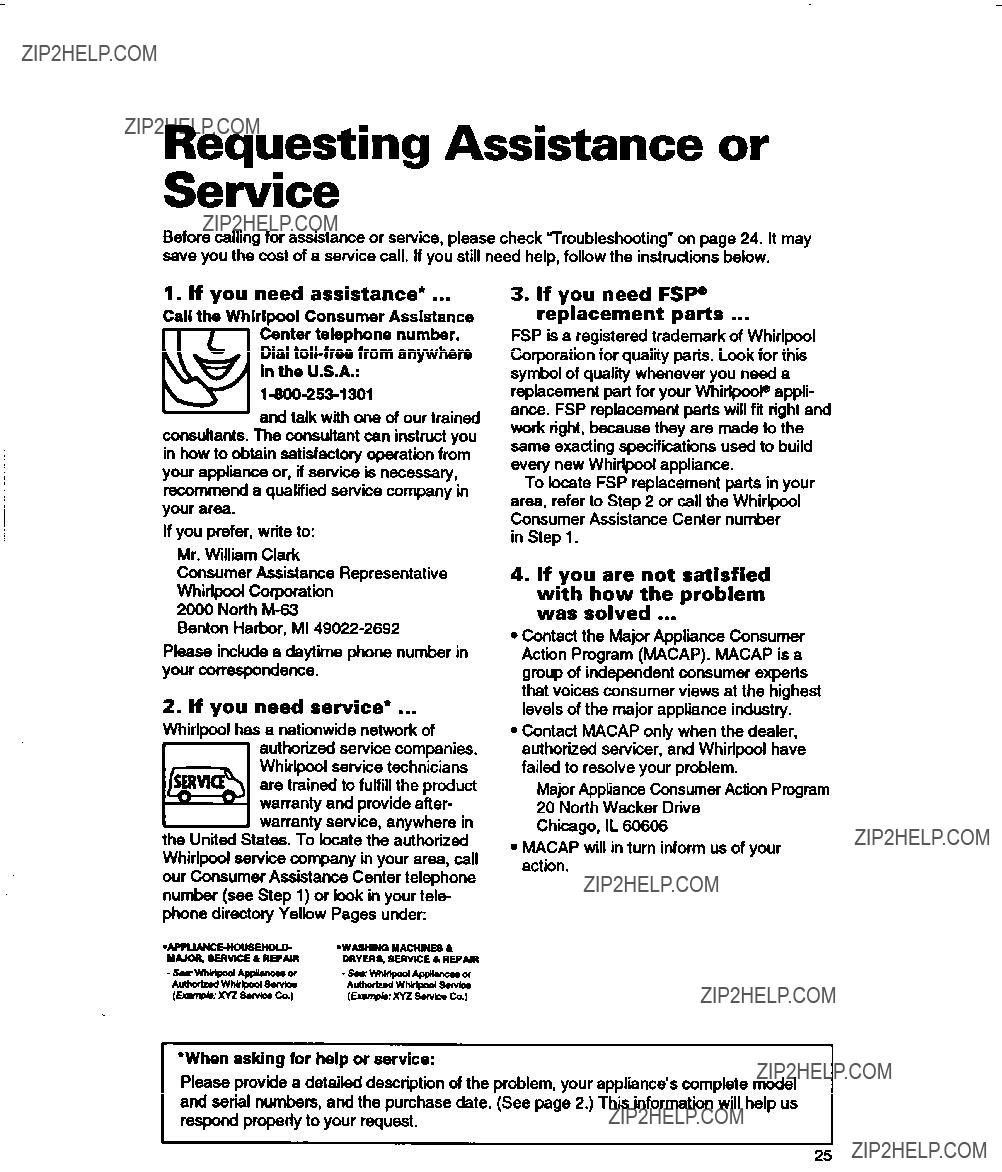
Reauestina Assistance or
Before calling for assistance or service, please check ???Troubleshooting??? on page 24. It may save you the cosf of a service call. lf you still need help, follow the instructions below.
1. If you need assistance* ...
Call the Whirlpool Consumer Assistance Center telephone number. Dial
wIn the U.S.A.:
consultants. The consultant can instruct you in how to obtain satisfactory operation from your appliance or, if service is necessary, recommend a qualified service company in your area.
If you prefer, write to:
Mr. William Clark
Consumer Assistance Representative Whirlpod Corporation
2000 North
Benton Harbor, MI
Please include a daytime phone number in your conespondence.
the United States. To locate the authorized Whirlpool service company in your area, call our Consumer Assistance Center telephone number (see Step 1) or look in your tele- phone directory Yellow Pages under:
3.If you need FSP replacement parts ...
FSP is a registered trademark of Whirlpool Corporation for quality parts. Look for this symbol of quality whenever you need a replacement part for your WhirlpooP appli- ance. FSP replacement parts will fii right and work right, because they are made to the same exacting specifications used to build every new Whirlpool appliance.
To locate FSP replacement parts in your area, refer to Step 2 or call the Whirlpool Consumer Assistance Center number
in Step 1.
4.If you are not satisfied with how the problem was solved ...
l Contact the Major Appliance Consumer Actiin Program (MACAP). MACAP is a group of independent consumer experts that voices consumer views at the highest levels of the major appliance industry.
l Contact MACAP only when the dealer, authorized servicer, and Whirlpool have failed to resolve your problem.
Major Appliance Consumer Action Program 20 North Wacker Drive
Chicago, IL 60606
l MACAP will in turn inform us of your action.
???When asking for help or service:
Please provide a detailed description of the problem, your appliance???s complete model and seriil numbers, and the purchase date. (See page 2.) This information will help us respond properly to your request.
25
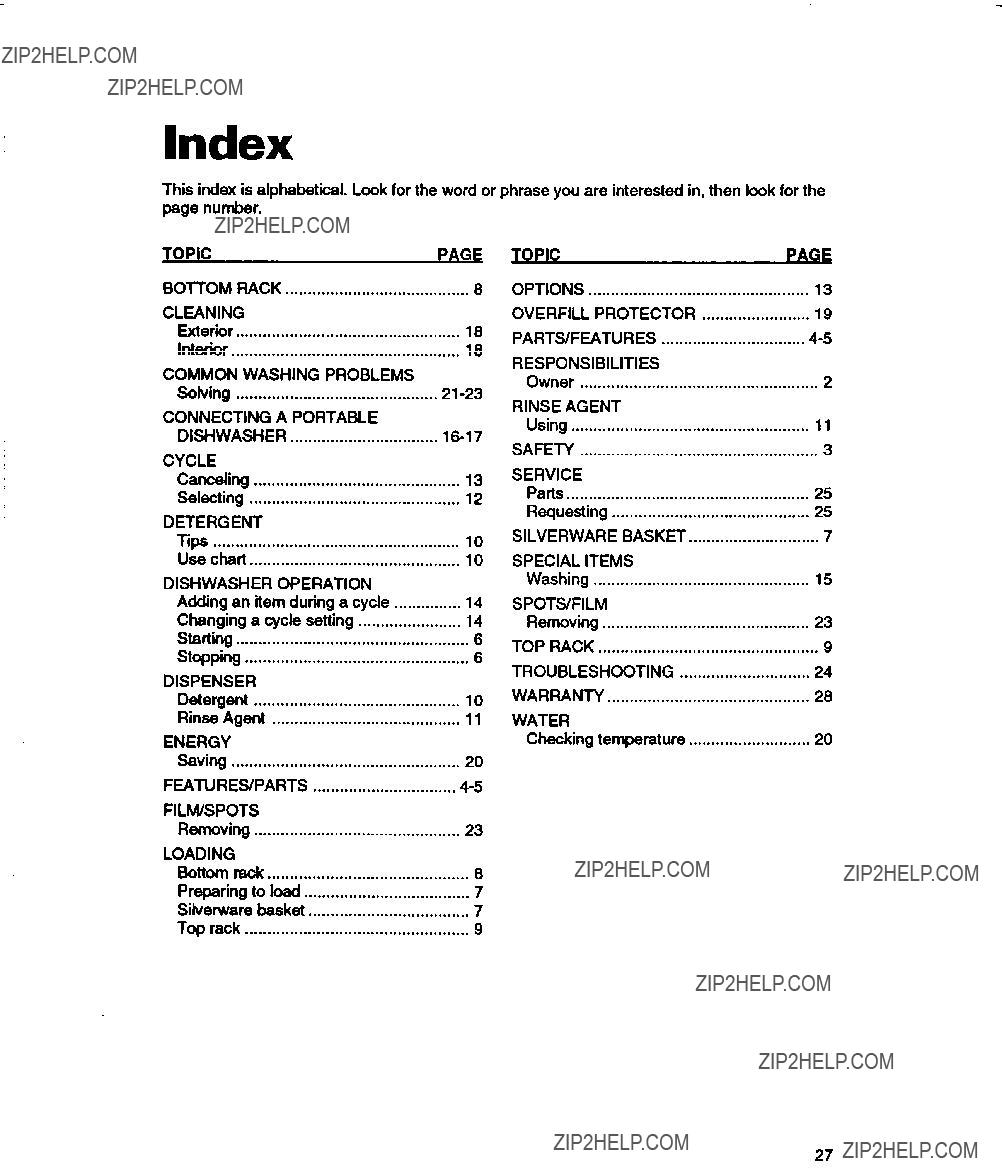
Index
This index is alphabetical. Look for the word or phrase you are interested in, then look for the page number. -
13
19
2
11
3
25
25
7
15
23
9
24
28
20
27

Service must be provided by an authorized Whirlpool service company.
WHIRLPOOL WILL NOT PAY FOR
A.Service calls to:
1.Correct the installation of the dishwasher.
2.Instruct you how to use the dishwasher.
3.Replace house fuses or correct house wiring or plumbing.
B.Repairs when dishwasher is used in other than normal,
C.Pickup and delivery. This product is designed to be repaired in the home.
D.Damage to dishwasher caused by accident, misuse, fire, flood, acts of God, or use of products not approved by Whirlpool.
E. Repairs to parts or systems caused by unauthorized modifications made to the
WHIRLPOOL CORPORATION SHALL NOT BE LlABLE FOR INCIDENTAL OR CONSE- QUENTlAL DAMAGES. Some states do not allow the exclusion or limitation of incidental or consequential damages, so this exclusion or limitation may nd appfy to you. This warranty gives you specifii legal rights, and you may also have other rights which vary from state
to state.
Outside the United States, a different warranty may apply. For details, please contact your authorized Whirlpool dealer.
If you need service, first see the ???Requesting Assistance or Service??? section of this book. After checking ???Requesting Assistance or Service,??? additional help can be found by calling our Consumer Assistance Center telephone number,
PART NO. 3373757 Rev. A